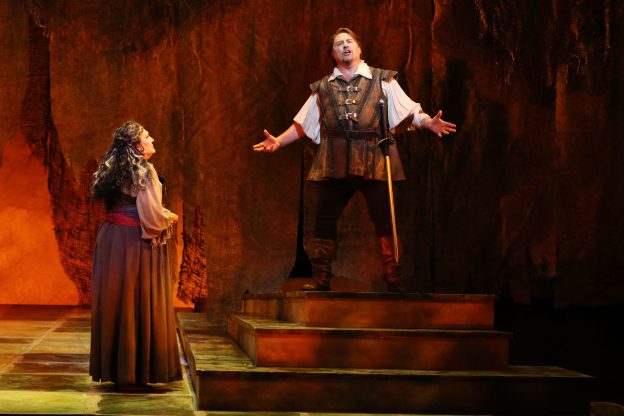
Star-Advertiser TGIF – ‘Il Trovatore’ has vocal demands & Plot Twists
The best revenge, the saying goes, is living well. But if you follow “Il Trovatore,” the Verdi masterpiece opening today at Blaisdell Concert Hall, it’s pretty difficult to pull off.
Set during the internecine 15th-century Iberian wars, the opera has so many twists and turns, it makes the most convoluted K-drama look like kid stuff.
There’s an obligatory love triangle involving the troubadour (“Il Trovatore”) Manrico, a wandering lute player, Count di Luna, his romantic and political rival, and the maiden Leonora.
There are also bizarre instances of mistaken identity, infanticide and confused family dynamics, not to mention a long-held grudge or two.
“It’s a great revenge story and quite dark,” said Paul Peers, guest director for Hawaii Opera Theatre. “Even I was surprised when I was going through the libretto. I thought, ‘Wow.’ But it’s also quite human. It’s extreme, but that’s opera.”
“Il Trovatore” also features great music, from singularly difficult solo arias and powerful ensembles to one of the great chorus numbers. It is one of the most popular works in the opera repertoire, and has been since its debut in 1853.
During the opera’s first three years alone, it was staged in six theaters in Naples and nearly 300 times worldwide.
“It was really, really popular,” said Peers, who is directing “Il Trovatore” for the first time. “It had that level of Broadway in its time.”
The plot is so complex that it might behoove opera goers to read the synopsis closely ahead of time.
Peers and company are working hard to make the story easy to follow so that you can enjoy Verdi’s beautiful, challenging music.
Verdi himself, asked what it would take to present “Il Trovatore,” replied, “The four greatest singers in the world.”
“I’ve really been thinking about how can I stage this so a non-Italian-speaking audience can understand it,” Peers said. “We’re really focusing on the storytelling, really focusing on the relationships between the main characters, and sculpting the characters in these three-dimensional human roles.”
Musically, “Il Trovatore” is best known for the famous “Anvil Chorus,” which has surfaced in everything from TV commercials to Bugs Bunny cartoons and a Marx Brothers film — “A Night at the Opera,” of course. The tune appears in the second act as an anthem of sorts for an oppressed gypsy community.
Here in Honolulu it will provide a chance for the HOT chorus to show how well it syncs up singing with sledge-hammering.
Peers, a native of Australia now based in New York, has been impressed by what he’s seen in rehearsal.
“There was no problem with the anvil-banging,” he said with a laugh. “They just nailed it, first go.”
For the artists, the opera presents challenges both musical and dramatic.
Portraying Manrico in his HOT debut is tenor Carl Tanner, who confesses that despite playing the role many times, he’s still somewhat perplexed by the character’s motivations.
Tanner actually took a hiatus from “Il Trovatore” several years ago, but said he was happy to revive it for Hawaii audiences.
“He’s kind of a lost character,” Tanner observed. Nonetheless, he’s warming to the performance.
Verdi presented the male lead with demanding vocal requirements. Two of Manrico’s major arias, in the third act, require singing in contrasting tones, from light romantic to heroic bravado, one after the other.
“I think the way Verdi wrote is difficult for a lot of tenors,” Tanner said. “You either have a lighter tenor trying to sing the heavier role, or you have a heavier tenor trying to sing the lighter parts. … I think I’ve found a happy medium.”
Tanner might have some real-life experience to draw on to help deal with the complexities of the role: Though schooled as a singer, he worked as a truck driver and a bounty hunter for years before returning to singing opera — after getting shot at.
He’s since become one of the world’s top tenors. There’s even a movie about Tanner’s life in the works.
“They were talking about Philip Seymour Hoffman, and obviously that didn’t happen, but now they’re interested in Jack Black,” Tanner said.
Baritone Michael Chioldi, who last appeared with HOT as the menacing Scarpa in “Tosca” three seasons ago, portrays Count di Luna, a man with conflicting interests — trying to win a war, win a woman’s heart and seek revenge for a crime perpetrated on his family.
“He’s stereotyped as the evil guy, but he’s not really an evil character in my opinion,” Chioldi said. “He’s just looking out for his best interests, but he’s in love. He’s looking for Azucena, who he thinks has burned his brother.”
Victoria Livengood portrays Azucena, a gypsy woman who not only committed infanticide but has other secrets as well.
“It took me about four productions for me to figure out what the heck I’m doing, myself,” said Livengood, who recently sang for HOT in “The Mikado” and “Dialogues of the Carmelites.” “This is gypsy-crazy, which is about as crazy as it gets.”
In contrast to Azucena is Leonora, the love interest of both di Luna and Manrico, who will be portrayed by Michelle Johnson in her HOT debut.
“I’m the normal one,” Johnson said with a laugh. “I’m the one who falls in love. …
“(Leonora) is young and she is a risk-taker, but she doesn’t come from craziness. She just comes from her pure heart.”
Johnson has won several competitions for young opera singers in the last five years. Although this is only her second production playing Leonora, she knows the story well.
“My first opera CD was ‘Il Trovatore,’” she said. “The story is ridiculous, but the music makes up for the plot.”
The soloists uniformly praised the production, expecting to deliver on Verdi’s “greatest singers in the world” requirement. That would fulfill the demands of his score, which is considered the ultimate test in “bel canto” operatic singing.
“‘Bel canto’ literally means beautiful singing,” Chioldi said. “And so you have this exposed, gorgeous line, and you have to be able to sing your most vulnerable and also be able to give your most powerful interpretation.”
“The four singers in this opera have to be at the absolute top of their game,” said Livengood, whose second-act aria “Stride la vampa” is one of the most tortured in all opera. “For all four of us, it’s the most challenging vocally of anything in the repertoire. It requires everything you have.”
By STEVEN MARK for TGIF (MAY 20)
